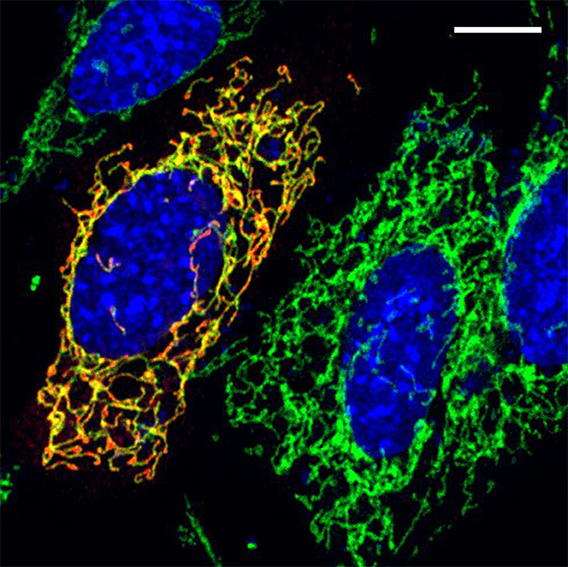Proof of Concept: Gene therapy for mitochondrial diseases

A virus-infected cell in a cell culture surrounded by uninfected cells. Mitochondria are shown in green. The virus shown in orange-red (left cell) is located to the mitochondria. Scale bars: 10 μm ©Mitochondrial Biology Unit, University of Cambridge
Every step we take, every laugh we make, every word we say requires energy. Mitochondria play a central role in our metabolism and energy production. Consequently, mitochondrial dysfunction causes a remarkably diverse group of metabolic diseases with a broad range of symptoms leading to severe disability.
“Since the 1980s it was known that mutations in the mitochondrial DNA can lead to disease” explains James Stewart, group leader at the Max Planck Institute for Biology of Ageing and continues “we have known of these patients for over 30 years and only now are we starting to develop treatments”.
A remarkable feature of mitochondria is that they contain their own DNA. Mutations in this mitochondrial DNA (mtDNA) can lead to mitochondrial diseases, but whether a person with a mutation develops disease or not is more complex.
Many copies of mtDNA are present in each of our cells and, normally, disease-causing mutations are present in only a fraction of them. However, if the fraction of mutated mtDNA molecules rises above a certain threshold, mitochondrial function is compromised resulting in mitochondrial disease. Therefore, reducing the levels of mutated mtDNA molecules is a potential treatment strategy.
However, this treatment strategy is not so straightforward as conventional gene-therapy approaches do not work in mtDNA. Scientists from the University of Cambridge, UK and the University of Miami, USA, developed an approach to specifically degrade mutated mtDNA molecules in cell culture.
Using a modified virus, they delivered a gene into the cell nucleus that encodes a protein that works as molecular scissors. These molecular scissors are then produced by the cell and targeted to mitochondria, where they specifically cut the mutated mtDNA.
But would the method also work in complex organisms composed of many tissues like mice or humans and actually treat mitochondrial disease? Stewart and his colleagues in Cologne could provide the answer. They had generated a mouse model of mitochondrial disease that contains a specific disease-causing mutation in mtDNA which leads to disorders in cardiac and muscular tissue.
They treated the animals with the virus that only infected the heart or the muscles. The virus delivered the molecular scissor to cut the mutated mtDNA in the targeted tissue. And in fact, the approach worked! The levels of mutated mtDNA were reduced and the disease symptoms were alleviated.
“This is the first gene therapy to actually remove the cause of a mitochondrial disease in a living animal” a delighted Stewart tells us. Of course, before the therapy can be applied to human patients more detailed work and safety assessments must be done.
Nevertheless, the scientists could prove that they found a way to remove the cause of these mitochondrial diseases. And since there is a link between mitochondrial dysfunction and other conditions like Alzheimer’s disease, Parkinson’s disease, diabetes, and perhaps some cancers, the approach will might even have a higher impact in fighting those disorders in the future.
Dr. James Stewart
Max Planck Institute for Biology of Ageing
Phone: +49(0)221 379 70 706
E-Mail: JStewart@age.mpg.de
Payam A. Gammage, Carlo Viscomi, Marie-Lune Simard, Ana S. H. Costa, Edoardo Gaude, Christopher A. Powell, Lindsey Van Haute, Beverly J. McCann, Pedro Rebelo-Guiomar, Raffaele Cerutti, Lei Zhang, Edward J. Rebar, Massimo Zeviani, Christian Frezza, James B. Stewart and Michal Minczuk: Genome editing in mitochondria corrects a pathogenic mtDNA mutation in vivo. Nature Medicine, 2018 DOI: 10.1038/s41591-018-0165-9.
Media Contact
More Information:
http://www.age.mpg.deAll latest news from the category: Life Sciences and Chemistry
Articles and reports from the Life Sciences and chemistry area deal with applied and basic research into modern biology, chemistry and human medicine.
Valuable information can be found on a range of life sciences fields including bacteriology, biochemistry, bionics, bioinformatics, biophysics, biotechnology, genetics, geobotany, human biology, marine biology, microbiology, molecular biology, cellular biology, zoology, bioinorganic chemistry, microchemistry and environmental chemistry.
Newest articles

Sea slugs inspire highly stretchable biomedical sensor
USC Viterbi School of Engineering researcher Hangbo Zhao presents findings on highly stretchable and customizable microneedles for application in fields including neuroscience, tissue engineering, and wearable bioelectronics. The revolution in…

Twisting and binding matter waves with photons in a cavity
Precisely measuring the energy states of individual atoms has been a historical challenge for physicists due to atomic recoil. When an atom interacts with a photon, the atom “recoils” in…

Nanotubes, nanoparticles, and antibodies detect tiny amounts of fentanyl
New sensor is six orders of magnitude more sensitive than the next best thing. A research team at Pitt led by Alexander Star, a chemistry professor in the Kenneth P. Dietrich…





















